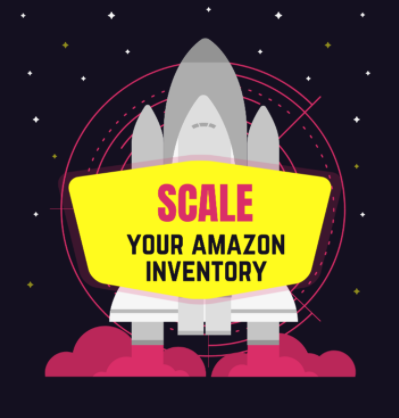Whenever sellers plan on scaling their Amazon orders, they always rely on the usual launching, reviews, and ranking strategies. But what if I tell you that all of the things mentioned are not enough to create a positive scaling process?
I'm Chelsea Cohen, and I am the co-founder of SoStocked.com. I'm here to share how to scale your Amazon business appropriately while sidestepping problems and losses.
Having worked with a lot of 7 to 8-figure Amazon business owners made me realize that there's a missing link to the usual approach in scaling an Amazon business. My experience in this field has helped me discover a technique that I would eventually apply even in my own Amazon business. And I would like to share this valuable knowledge with you to help your business grow and reach success.
In this article, you're going to learn how to properly use my inventory planning technique to streamline your systems and avoid struggles in your business. I will also give a free Amazon Inventory Scaling Planner to download, and talk about an inventory management software that will provide massive assistance to you.
Let's get started!
The Misstep That Results To The Weak Link
As I've stated earlier, I talk to various businesses about how they plan their Amazon inventory.
My role in SoStocked.com requires me to conduct these one-on-one conversations with various Amazon sellers from different spaces. You name it, private label, wholesale, and retail arbitrage spaces, I get to talk to all of them. And their concerns will all boil down to one topic: the significant effect of inventory management on their bottom lines and cash flow.
Now it's safe to say that these businesses' top misstep is the failure to manage their Amazon inventory. But if we look deeper and dissect these conversations thoroughly, we'll find the real weak Amazon scaling link. I did precisely that, and I have concluded that the main problem is not the SOPs, the ranking, or the hiring of VAs. The main problem is that these Amazon sellers run their marketing without keeping the inventory aspect in mind.
It's a problem that often gets left out in the scaling space, but I'm here to show you how to change that.
The Missing Link That Provides A Solution
I understand why people in the Amazon space prefer not to talk about their inventory management. I also sell on Amazon, and I get the stress it brings due to the amount of guessing you need to perform. For many years, I have learned the ins and outs of Amazon inventory management. It wasn't easy, but if I'm going to give you one primary lesson from that experience, I will tell you that it's time to include this topic into the Amazon space. It's time to be aware of its importance to the scaling process.
If your old ways tell you to simply trust your gut when it comes to scaling your Amazon business, you need to replace that way of thinking. Amazon inventory management should be planned out in combination with marketing to create a smooth process in scaling your orders. And to make it easier, you can do it by implementing my technique. It's time for you to learn about inventory syncing.
Sync Up So You Can Scale Up
Amazon inventory management is the most overlooked topic by sellers. Marketing has the most attention, and they always talk about the latest, greatest marketing tactics. But sellers should know that syncing your marketing efforts with your inventory is not the discussion's end. You should also sync up these two with cash flow.
As I've mentioned earlier, I have a free Amazon Inventory Scaling Planner provided for you. It allows you to see how crucial it is to organize your systems to scale correctly. And if you look at the different elements and workflow in it, you will realize that the marketing team will have to seek approval from the inventory before it launches the campaign. Why? Because if you don't, you could run into a lot of problems.
Let's look at some of the examples:
For starters, many sellers have told me that they canceled promotions because the inventory was not enough to execute it properly. And the root cause of this? No inventory planning.
Here's another misstep: sellers tend not to plan thoroughly enough. Let's take this as an example: focusing too much on a specific holiday like Valentine's Day but neglecting the other holidays on the calendar.
Here's what happens, the marketing team conducts email campaigns that include 10% off their items on Valentine's Day or Mother's Day. But when Father's Day comes, they are forced to lessen the marketing efforts because they have run out of stock. In the end, they gave away a 10% discount and worse, they have decreased sales. Even if your marketing team claims that this campaign will work but fails to consider the other elements, it's better not greenlighting it.
But here's another dilemma: how can you sync up these three more efficiently? This is where useful software comes to the scene.
The Amazon Inventory Management Software
Instead of wasting your time on spreadsheets and multiple software that don't fit your needs, you need to learn how to identify the perfect software that will offer the help you're looking for. Below are some of the tips you can apply in your searching process:
- The software should allow for full customization
- You can understand how the algorithm works
- Adjusting inventory calculations on an SKU level should be included
- Good inventory software will give you forecasts, not just for your FBA inventory but also your warehouse inventory.
- It should give you the ability to create marketing plans and include them in your inventory planning.
- Last but not least, the software should help you to perform accurate inventory planning.
Remember that the perfect software's primary goal is to make things more convenient for you.
Let's Talk About The Process
It's best to coordinate with all of your teams to have a positive scaling experience.
When you have a streamlined workflow and concrete system, you're scaling up to increase your sales consistently over time. These past numbers that you're analyzing are not just mere numbers. They bring more to your business. They are helping you come up with enough inventory that will support your marketing plan's execution.
Marketing With Inventory Management
An inventory timeline is one of the most valuable things to sync your marketing project, inventory, and logistics. You need to keep up with the daily and seasonal growth in your calculations. Many software in the market lack an inventory timeline feature wherein you can thoroughly plan marketing efforts. They mostly give you a forecast of how much you will order based on your previous sales solely. They don't provide you an opportunity to create a layout of your marketing campaigns in the future.
A good inventory planning system allows you to develop a marketing plan that syncs up with your inventory and helps you avoid losing money. You will learn if your project is feasible or if it needs more adjustments.
Cash Flow With Inventory Management
When you finish the revisions and changes based on your inventory, it's time to send your marketing plan to the accounting team. Your accounting team’s main job is to ensure that you have funds to cover the marketing campaign's expenses and inventory needs. Here are the questions that will help the accounting department in fulfilling their task:
- How much are the estimated sales of this project?
- What's the predicted income, and when will it be realized?
- How much money is to hand?
- What additional funds are available or that can be applied for if that is needed?
They have to be realistic when it comes to the capital needed to execute the marketing project. In this way, you can achieve your goals successfully.
Sync Up. Scale Up. Stay in Stock.
Now that we've everything laid out, the main lesson to be learned here is to have all three teams work together. No team is more important than the other. They all play a massive role in the scaling process. If you're able to sync up these three, then you can scale up appropriately.
We've provided you with the cheat sheet in our downloadable Amazon Inventory Planner that you can implement on your scaling management. Be sure to download it now so you can start implementing these strategies immediately.
If I have missed out on other helpful tips on this topic, please feel free to comment below, and I would love to have a meaningful conversation with all of you.











